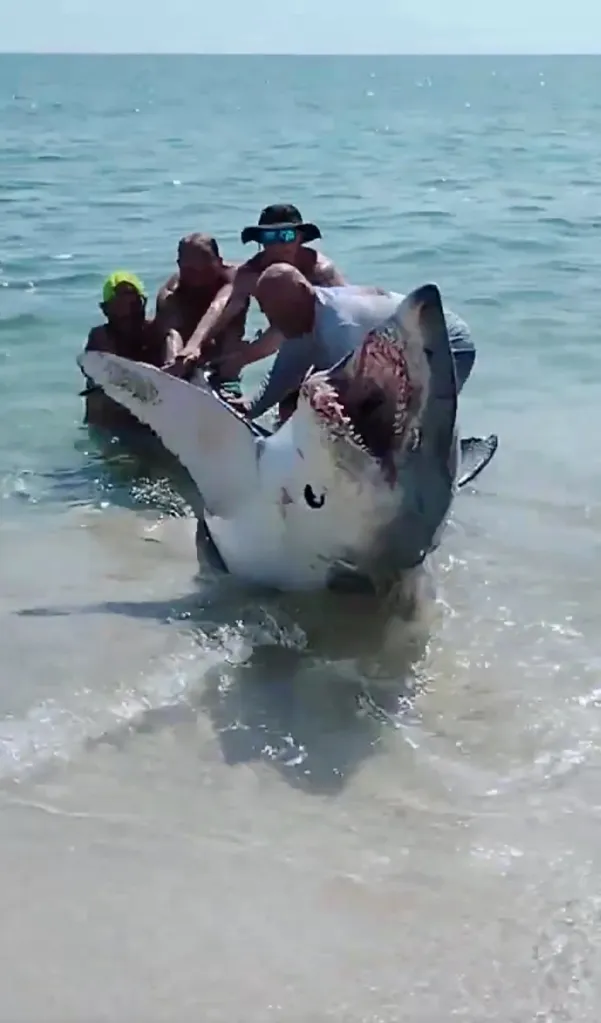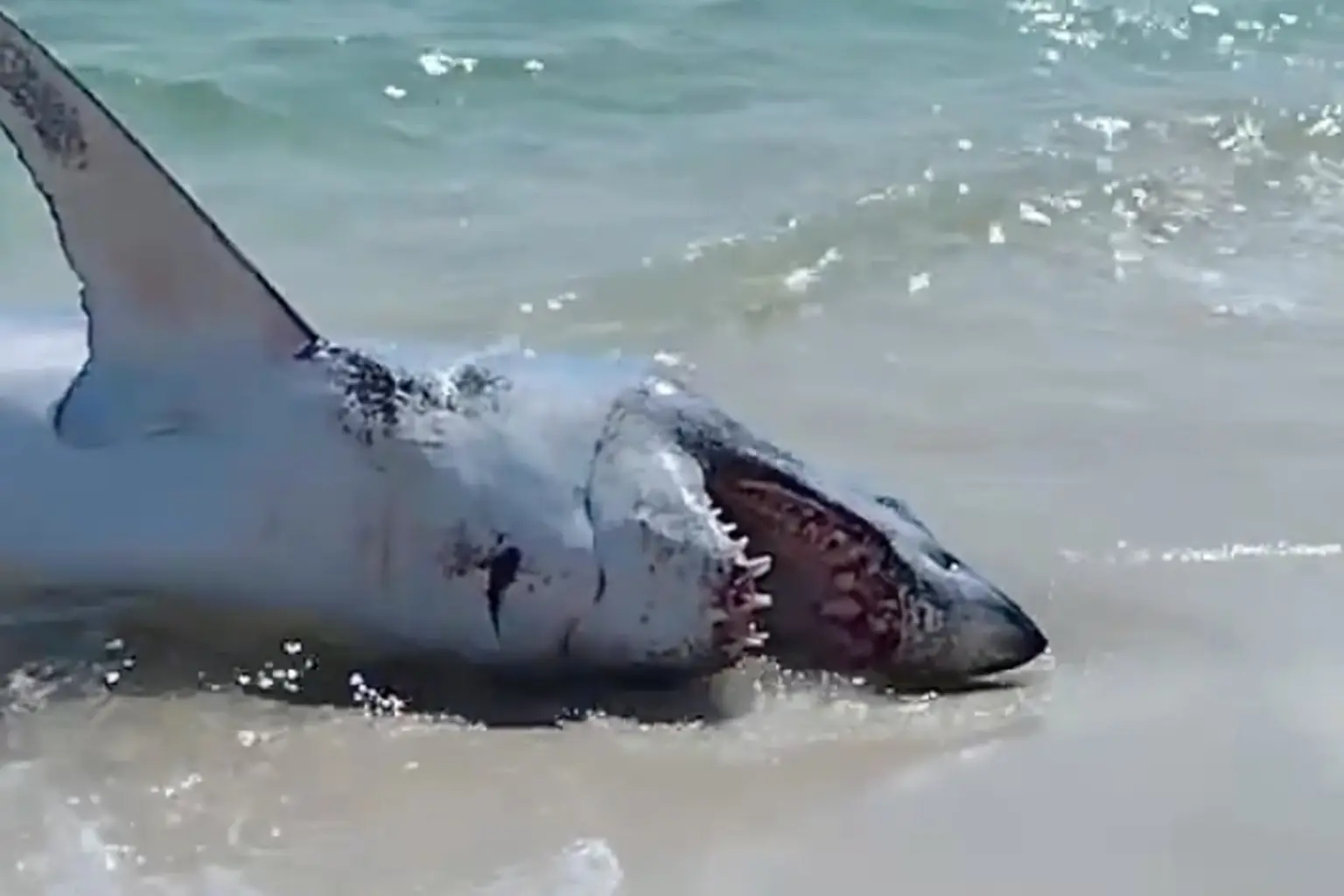Sometimes, real courage doesn’t roar — it wades into the surf. On a sunny afternoon in Florida, a group of beachgoers found themselves in a once-in-a-lifetime rescue when a massive shark became stranded on the sand. What followed was a tense, dangerous, and unforgettable effort to save one of the ocean’s most feared — and misunderstood — creatures.
The Unexpected Visitor
The drama unfolded on a quiet Florida beach where families were enjoying the day, until someone spotted a dark shape moving rapidly toward shore. Within moments, the shape broke the surface — a massive mako shark, likely weighing hundreds of pounds, thrashing as waves pushed it farther onto the sand.
One witness described the moment as “surreal.” “The shark was moving fast,” said the woman who captured the video. “Then suddenly it was stuck, just lying there, struggling.”
The stranded predator, gasping and twisting in confusion, was in grave danger. Sharks, unlike many fish, must keep moving to breathe — when stranded, their gills can quickly fill with sand and suffocate them.

Also Read: Man Loses 360 Pounds Naturally — Internet Rallies to Support His Next Step
A Dangerous Decision
The woman’s husband was the first to act. Ignoring the shouts of concern around him, he ran straight toward the struggling shark. “After a few seconds of seeing it try and fail to get back in the water, my husband took charge,” she said.
The shark’s powerful body dwarfed him as he grabbed hold of its tail fin. Every pull toward deeper water was met with a violent thrash. The mako’s body twisted with force, its razor-edged jaws snapping at the air in instinctive panic.
“Babe, it’s too dangerous! Don’t be doing that!” his wife yelled from behind the camera. But he didn’t stop.
The struggle was fierce — man versus nature, but with compassion as his weapon. The waves fought against him, the sand dragged at his feet, and the shark’s strength threatened to hurl him off balance.
Then, two other men rushed to help. Together, they gripped the creature’s tail and began heaving it back toward the surf.

A Glimpse of Power
As the rescuers worked, the shark’s mouth opened wide, displaying rows of jagged, glinting teeth. “Babe, look at them freakin’ teeth!” the woman cried out. It was a reminder of the razor’s edge between bravery and recklessness — a single wrong move, and this would no longer be a rescue, but a tragedy.
Even as they struggled, none of the men tried to touch the shark’s head or mouth — a crucial instinct. They focused on the tail, using their strength to drag it just far enough that the next strong wave could help carry it back.
Every surge of water gave the shark a bit more life. Every push forward felt like a victory.
Finally, after several exhausting minutes, a larger wave rolled in — and the shark, now partially buoyant, twisted violently, freeing itself from the sand.
It turned, its sleek gray body gliding back toward the open sea. Within seconds, it disappeared beneath the waves, leaving behind only froth and adrenaline.
Full Story: The Hidden Meaning Behind Princess Diana’s Cannes Gown — A Heartfelt Farewell to Grace Kelly
Cheers, Relief, and Reflection
The moment the shark vanished, the beach erupted in cheers. The men collapsed in the shallow water, catching their breath, hands trembling. “We couldn’t just watch it die,” one of them said afterward.
The woman behind the camera could be heard sighing with relief. “That was the scariest thing I’ve ever seen,” she said, still in disbelief at what had just unfolded.
For a brief moment, danger and humanity had collided — and compassion had won.
Why Sharks Strand Themselves
Experts later explained that strandings like this are rare but not unheard of. Mako sharks, known for their incredible speed, sometimes chase prey too close to shore. When strong tides or shallow slopes meet their momentum, they can become trapped.
Dr. Jenna Alvarez, a marine biologist at Florida Atlantic University, noted, “Sharks are not beach dwellers — they’re designed for deep, open water. When they hit sand, their physiology works against them. They literally can’t push themselves backward.”
Without help, most stranded sharks die within minutes. But in this case, human intervention — risky as it was — made the difference.
Courage vs. Common Sense
Not everyone praised the rescue. Some marine safety experts cautioned against attempting to move large, dangerous animals without professional help. “You should always call wildlife officials first,” said one responder from the Florida Fish and Wildlife Conservation Commission. “Even well-intentioned rescues can go wrong very quickly.”
Still, the man’s instinct to help struck a chord online. Commenters called him brave, compassionate, and even “fearless.” Others called him lucky — pointing out that a shark that size could have easily injured or killed him.
Both can be true.
Sharks and Misunderstanding
Sharks often get cast as villains in ocean stories, but they are among the most vital creatures in marine ecosystems. As apex predators, they regulate fish populations, remove the weak and sick, and maintain balance in the ocean food chain.
Their presence means the ocean is healthy. Their absence signals decline.
This rescue wasn’t just a single act of kindness — it symbolized something larger: a rare human acknowledgment that even fearsome creatures deserve a chance to live.
Florida’s History with Shark Encounters
Florida has one of the highest rates of shark encounters globally, but fatal incidents are exceedingly rare. Most are cases of mistaken identity or territorial defense. Yet, sharks still evoke primal fear — a fear fueled by decades of sensationalism and misunderstanding.
This video, though, tells a different story: not of danger, but of coexistence.
A Lesson Beneath the Waves
The ocean doesn’t belong to us — we’re just visitors. The men who pulled that shark to safety didn’t conquer it; they respected it. They saw a creature in distress and chose to act.
Their rescue wasn’t perfect, or even entirely safe — but it was human in the best sense of the word.
As one bystander put it, “He could’ve walked away, but he didn’t. He saw life struggling, and he helped.”
That simple instinct — to help, not harm — is what keeps the wild world alive.
The Takeaway
When the ocean meets the sand, the line between life and death can be as thin as a wave. That afternoon in Florida, three strangers crossed it — not to fight nature, but to give it a hand.
And when the shark finally slipped beneath the surface, the sea took it back — proof that compassion doesn’t always roar. Sometimes, it just pulls quietly toward deeper water.



